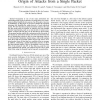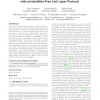1351 search results - page 220 / 271 » Trust in Anonymity Networks |
TISSEC
2010
14 years 10 months ago
2010
An all too real threat to the privacy offered by a mix network is that individual mix administrators may volunteer partial tracing information to a coercer. While this threat can ...
ESORICS
2010
Springer
14 years 10 months ago
2010
Springer
Transmitting voice communication over untrusted networks puts personal information at risk. Although voice streams are typically encrypted to prevent unwanted eavesdropping, additi...
115
click to vote
IH
2010
Springer
14 years 9 months ago
2010
Springer
Abstract. Statistical disclosure is a well-studied technique that an attacker can use to uncover relations between users in mix-based anonymity systems. Prior work has focused on f...
138
click to vote
ICC
2011
IEEE
13 years 11 months ago
2011
IEEE
—Anonymity is one of the main motivations for conducting denial-of-service attacks. Currently, there is no mechanism to either identify the true source of an IP packet or to prov...
MOBISYS
2008
ACM
15 years 11 months ago
2008
ACM
We present the design and evaluation of an 802.11-like wireless link layer protocol that obfuscates all transmitted bits to increase privacy. This includes explicit identifiers su...


